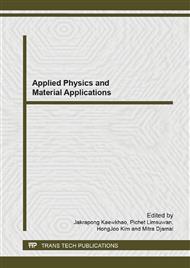p.157
p.161
p.165
p.169
p.173
p.177
p.181
p.185
p.189
Growth of Anatase TiO2 Thin Film for Photokilling of Bacteria by DC Reactive Magnetron Sputtering Technique
Abstract:
Titanium dioxide (TiO2) thin films have been deposited on Si-wafer and glass slide by DC reactive magnetron sputtering technique at different O2 gas flow rates. The crystal structure was characterized by grazing-incidence X-ray diffraction (GIXRD), surface morphology was analyzed by atomic force microscopy (AFM) and disinfection of surfaces by photo catalytic oxidation with TiO2 and UV light irradiation. The results showed that, from GIXRD results, all as-deposited TiO2 films have crystal structure of TiO2 corresponding to the A(101) and A(200). AFM results showed that the film thicknesses increase from 183 nm to 238 nm with increasing of O2 gas flow rate, while the film roughness was in range of 4.8 nm to 5.9 nm. The as-deposited anatase TiO2 thin film in this work can kill the bacteria when expose to the UV light.
Info:
Periodical:
Pages:
173-176
Citation:
Online since:
September 2013
Price:
Сopyright:
© 2013 Trans Tech Publications Ltd. All Rights Reserved
Share:
Citation:


